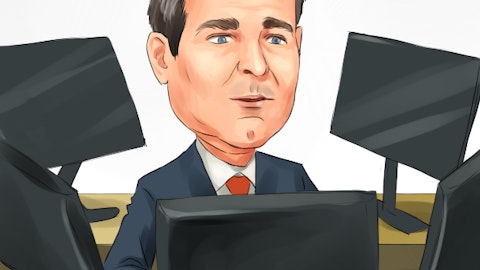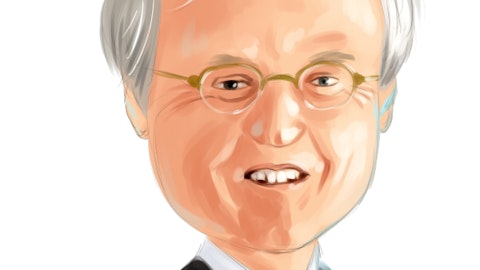Mike Kuta: Yes, I think the frac and wireline is just very focused on the basics, right, quality, on-time delivery, delivering the best tech in the industry. And if we can do that and continue to do that, I think we’re going to be okay there.
Stephen Gengaro: All right. And then just one final, when we think about the quarter, the third quarter results and as we lead into the next quarter and the next year, how do we think about incremental margins or margin trajectory in Arcadia and Dyna as you get into 2024? And we’re kind of assuming some level of recovery and tracking completion activity next year. But as you get growth in the businesses, is there a way to kind of think about the incremental margin contribution or margin trajectory in those two businesses?
Mike Kuta: Yes, I’ll start and Eric will finish. I think with Arcadia, it’s a pretty high variable cost-type business. So, we’re going to — we’re in the right ZIP code now from a margin standpoint. We should probably be operating in that area for Q4 and beyond. DynaEnergetics, a bit more absorption impact there. We’ve got a lot of projects that we’re doing to drive margin from an internal standpoint. And we’ve cited some of them, but lean initiatives, automation, we’ve done some cost reductions as well. So, we think we can drive margin — continue to drive margin into 2024, probably flat Q3 to Q4, but we’ve got a lot of things that are in the — kind of in our project plan for 2024 to continue to drive margins, things that are under our control.
Eric Walter: Yes, the only thing I would add to what Mike said is that for Dyna, the focus really is going to be more on their EBITDA margins as opposed to the gross margins. Gross margins will always be important. But some of the initiatives that Mike pointed to around SG&A control, they’re really going to manifest themselves in the EBITDA margin line as opposed to gross margin. And we continue to believe that this is a 20%-plus EBITDA margin business and want to make sure that we put in these initiatives so that we not only get back to that, but we stay there.
Stephen Gengaro: Okay. Thanks. I’ll get back in line here. Thank you.
Operator: Thank you. Our next question is from Katie Fleischer with KeyBanc Capital Markets. Please proceed with your question.
Katie Fleischer: Hi, good afternoon. I’m on for Ken Newman today.
Mike Kuta: Hi.
Katie Fleischer: Hi. I wanted to talk a little bit about your capital allocation. So, free cash flow is pretty strong in the quarter. Can you just talk about expectations for free cash flow generation going forward? And then what some of your capital allocation priorities would be?
Eric Walter: Yes, thanks for the question. So, for Q4 and what I would say going into 2024, we’re really trying to drive the businesses to have a higher free cash flow conversion. So, if you did the math for Q3, we would be up around 70%. I’m not sure that we can do that every quarter, but typically in the second half of the year because of seasonality, we tend to be around that range. So, in Q4, we would be looking to be up in that ballpark as well. And then, going forward into next year, a lot of the things that Mike was talking about earlier when he answered the question about initiatives, they have a P&L impact, but they also have a cash flow impact as well, whether it’s reducing SG&A or driving higher inventory turns. So, we would look to try to build on that momentum and make sure that we can keep the conversion at a higher rate.
And in terms of how we allocate the capital, we are looking to continue to delever the balance sheet. So, that’s going to be one area, but we’re also putting CapEx back into the business. So, for Arcadia, Mike mentioned the paint line where we’re going to be looking to do some industrial engineering. We’re also going to be looking at making some investments in the anodizing area as well, which will help broaden margins for the Arcadia business. And for Dyna, it’s going to be mainly focused on a lot of the internal initiatives around automation and trying to make sure that we can produce our products as efficiently as possible, which should also have an impact on sustainable quality levels. So, I think, in terms of where we want to be from a cash flow standpoint, we have a good Q3.
We want to make sure that that’s not just a onetime type of performance, but we can continue that going forward. And then, in terms of the allocation, we’re going to be looking to continue to delever, but also reinvesting back in the business in some of these important initiatives.
Katie Fleischer: Okay. Great, that’s helpful. And then, on the well completions, do you guys have any sort of, I don’t know, it’s difficult in this type of environment, but any sort of view in terms of where those are headed as we kind of close out the year and go into 2024?
Eric Walter: Yes, I think that what you’re going to see is pretty steady through the end of the year, probably hit some seasonality at the end of the year with budget exhaustion and I think then you’re going to see a pickup in 2024.
Katie Fleischer: Okay. And then, just one last one, switching to Arcadia here. Can you give a little bit more detail about the ERP system, like how much capacity that can add? Maybe any impacts on costs or margins would be helpful?
Mike Kuta: Yes. So, the ERP system probably wouldn’t add any capacity, but what it’s going to allow us to do is to have better controls and better visibility into data. And so, the first one is probably pretty self-explanatory. But the second one, what we mean by that is that we think that it’s going to prevent any type of margin leakage between changes in aluminum costs and our ability to pass that through to customers. But another benefit that we’re really excited about is, it should also allow us to be more efficient from an inventory turn standpoint. So, if you think about our business model, we’ve got a hub and satellite type of structure. With this newer ERP system, we’re going to have a better understanding of where that inventory is, how it’s turning at the different satellites, and how we can transfer it from maybe one satellite where it’s moving slower into another one where it’s moving faster.
So, we’re excited about that, and we’re just in the early days of going through the implementation, but I think it’s going to pay dividends long-term.


